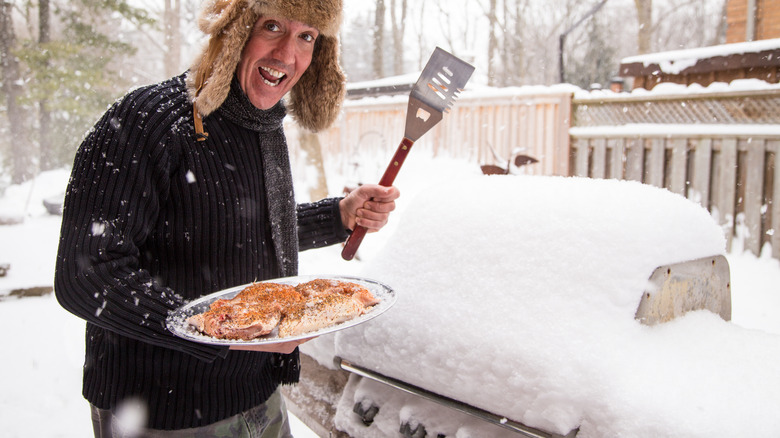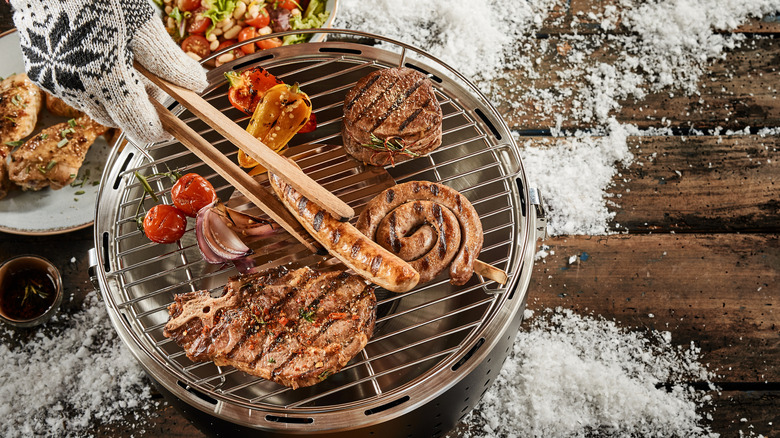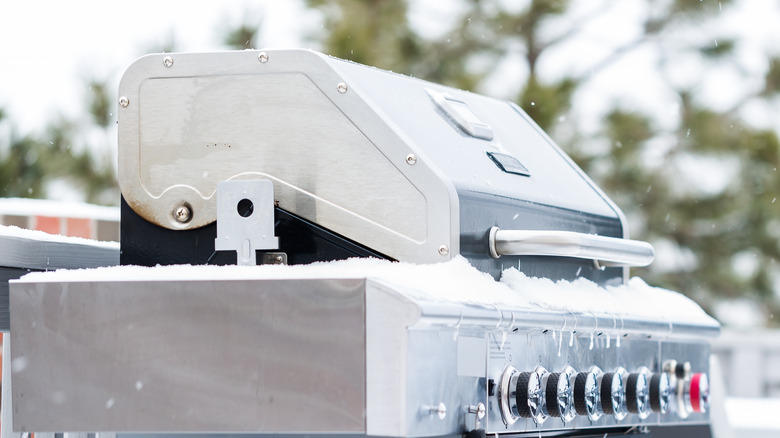You Don't Have To Give Up Grilling Just Because It Snows
When the days darken, air temperatures begin to plummet, and snow begins to pile up, you know that winter has truly arrived. In the colder regions of the country, the winter season comes with a slew of sacrifices. Your skimpy swimwear is swapped out for jumbo jackets, and you're forced to close your car's convertible roof in favor of strapping its tires with chains. Perhaps the most disheartening loss of the winter months is that of your grill, which spends the season buried under a blanket of snow. This issue is exacerbated by the fact that a hearty meal is best enjoyed amid cold weather (per The Conversation). What could possibly be a more effective way to bulk up before your long winter's nap than eating a thick, juicy grilled steak?
Fortunately, the coming of winter does not need to be a death sentence for your grilling season. Though snowfall can lead to rust, both on your grill and in your culinary skillset, if you take the necessary precautions, snow won't stand in the way of you and your grill (via Char-Broil).
A few simple steps can turn grilling into a year-round activity
According to Consumer Reports, the first step to grilling when things have taken a turn for the snowy is to perform a thorough grill check. This includes ensuring that none of your grill's moving parts have frozen stiff, and also checking if there are any snow blockages that could lead your grill to accumulate dangerous gasses. One way to gauge whether or not your grill has developed a block is to check the flame's color, which should be blue. A yellow flame could mean an issue with your gas flow. In order to protect against potential poisonings, your grill should be kept 10 feet from your home.
Additionally, you want to make sure that your winter wear doesn't put you at risk. Consumer Reports advises against wearing any loose-fitting garments that could accidentally come into contact with your grill's flame. Additionally, they say you should wear gloves that still allow for full dexterity.
Even if you ultimately decide that you'd rather just cook in the kitchen during the winter months, you should keep your grill covered to keep it from being damaged by snow and ice, per Food Network. Then, when the sun returns, you simply need to start grilling season by cleaning your grill, emptying the grease traps, and refueling. Then you're good to go.
When grilling in winter, temperature control is essential
Whenever you're grilling, consistent temperature is key. In winter, this becomes more difficult to control. According to Kevin Kolman, the head grill master for Weber, a grill manufacturer, your grill will use up considerably more fuel in the cold weather, so you're going to want to have a surplus supply on hand (via Food Network). Even if you have an appropriate amount of fuel on hand, maintaining your grill's temperature will still be tricky. Kolman also explains that your grill's preheating process could take about 25% longer in the winter. Additionally, keeping the lid of your grill closed is more important than ever, as letting in too many bursts of frigid air can considerably lengthen your cook time.
Gourmet Grills provides a handy way to calculate for winter grilling. They suggest that once the weather dips below 45 degrees Fahrenheit, for every additional five-degree drop in temperature, you will likely need to grill your meat 20 minutes more per pound.


